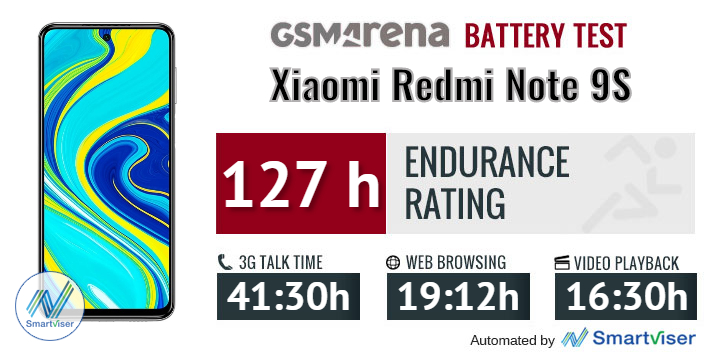Xiaomi Redmi Note 9S / 9 Pro review

Display
The Redmi Note 9S features a large 6.67" IPS LCD display with a punch hole notch at the top to make room for the selfie camera. The resolution is extended 1080p - 2,400 x 1,080 pixels - making for a 395ppi density.
The backlighting around the round notch is uneven and it is easily visible on white background. So, be prepared to see this imperfection a lot. Such uneven backlighting is a pretty glaring disadvantage of the LCD panels when compared to OLEDs.
The Redmi Note 9S display is protected with a Gorilla Glass 5, but this Redmi also ships with a screen protector that's been applied in the factory.

The Redmi Note 9S display supports HDR10, and it can display 1080p HDR content from Netflix and the likes thanks to the Widevine L1 DRM support.
Xiaomi promises 1500:1 contrast ratio for the Note 9S screen, and our measurements show it is in the ballpark of the promised value. The maximum brightness is about 420 nits, while the black levels are deep enough at 0.3. The screen can be brighter though if you leave it on Automatic Brightness - it can light up as high as 575 nits in bright ambient light.
The minimum brightness we captured on the white color is 1.1nit - a perfect one for reading sessions in the dark!
| Display test | 100% brightness | ||
| Black, |
White, |
||
| 0.303 | 421 | 1389:1 | |
| 0.42 | 575 | 1369:1 | |
| 0.331 | 450 | 1360:1 | |
| 0.453 | 600 | 1325:1 | |
| 0.343 | 451 | 1315:1 | |
| 0.328 | 528 | 1610:1 | |
| 0.318 | 421 | 1324:1 | |
| 0.425 | 461 | 1085:1 | |
| 0.501 | 515 | 1028:1 | |
| 0.399 | 550 | 1378:1 | |
| 0.527 | 714 | 1355:1 | |
| 0.347 | 460 | 1326:1 | |
| 0.486 | 640 | 1317:1 | |
| 0 | 413 | ∞ | |
| 0 | 636 | ∞ | |
Xiaomi offers three different Contrast settings for the Redmi Note 9S display. With the Automatic contrast set to on, the screen output seems to be tuned for accuracy in the sRGB color space, and we measured an average deltaE of 5.9. Only in this mode, you can choose the color saturation (default, warm, cool) and the Delta E of 6.3 was measured with the Default preset. Choosing warm will diminish the noticeable blue tint but won't improve the overall accuracy by much.
The Standard Contrast setting has superb accuracy within the sRGB color space, and we recorded an average deltaE of 2.1 for color accuracy.
Finally, the Increased Contrast makes the colors pop at the expense of reproduction accuracy.
Battery life and charging
The Xiaomi Redmi Note 9S is powered by a large 5,020mAh Li-ion battery. It supports 18W quick charge, but the 9S ships with a 22.5W brick - meaning you will be overequipped. Xiaomi says it is one of their universal chargers for smartphones, smart home accessories, tablets and even small laptops.

The bundled charger refills about 37% of the entirely depleted battery in 30 mins, 60% in 50 mins, while a full charge takes about 1 hour and 45 minutes.
The Redmi Note 9S scored an outstanding endurance rating of 127 hours in our battery life test. The phone shows impressive times across the board - talk time, video playback and web browsing, even standby.

Our battery tests were automated thanks to SmartViser, using its viSerDevice app. The endurance rating above denotes how long a single battery charge will last you if you use the Xiaomi Redmi Note 9S for an hour each of telephony, web browsing, and video playback daily. We've established this usage pattern so that our battery results are comparable across devices in the most common day-to-day tasks. The battery testing procedure is described in detail in case you're interested in the nitty-gritty. You can check out our complete battery test table, where you can see how all of the smartphones we've tested will compare under your own typical use.
Speaker
The Redmi Note 9S has no special treatment for its loudspeaker. It's a single piece, bottom-firing, and tuned mostly for louder mid-tones. It posted a 'Good' result for loudness in our seven-track music test. It lacks a low-frequency thump, but it handles vocals well.
Use the Playback controls to listen to the phone sample recordings (best use headphones). We measure the average loudness of the speakers in LUFS. A lower absolute value means a louder sound. A look at the frequency response chart will tell you how far off the ideal "0db" flat line is the reproduction of the bass, treble, and mid frequencies. You can add more phones to compare how they differ. The scores and ratings are not comparable with our older loudspeaker test. Learn more about how we test here.
Reader comments
- amirsalimi
- 05 Dec 2024
- nxu
Very good phone Only disconnected nearby device and Not connected Radionet and smart card device
- Jeanosy
- 20 Jul 2024
- kb4
I have used mine for 4 years now. No issues. The Battery strength is second to none.
- manyord
- 07 May 2024
- XBq
My dad bought it in 2020 as well and around 2023 it got battery drain issues, part of it from firmware updates and battery health as well. so far in 2024 it has 79% health which is alright but wish it lasted longer like its expensive brothers